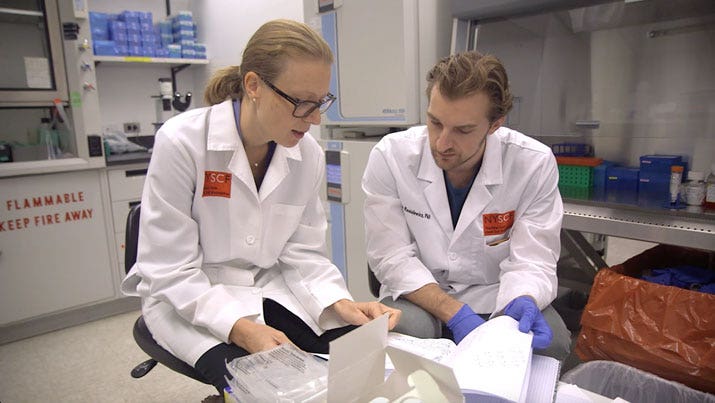Why Stem Cells Are the Future of Medicine

Susan Solomon has found a way to unlock stem cells’ potential to treat disease.

Susan Solomon
Sometimes it takes a profound experience to change the trajectory of a life. In Susan Solomon’s case, it was the type 1 diabetes diagnosis of her son, Ben, in 1992. It launched her into a journey that led her to a life of advocacy for an emerging health science and, ultimately, to her current role, positioned at the beginning of medicine’s future.
Like many parents faced with a disease affecting their child, Solomon became a researcher, learning everything she could about juvenile diabetes, and even became active on the Juvenile Diabetes Research Foundation board. This led her to meet 1989 Nobel Laureate Harold Varmus, MD, who was interested in human embryonic stem cells. From her conversations with him and other scientists, Solomon realized that stem cells are a promising way for the most-advanced medical research to quickly translate into cures. This was at a time when stem cell research was in its infancy and a hot-button political issue. Funding was difficult to obtain, and states like California had become funders of stem cell research.
In 2005, taking inspiration from California, Solomon and Mary Elizabeth Bunzel co-founded the New York Stem Cell Foundation aka NYSCF. “Or, ‘nice if,'” Solomon says of the foundation for which she serves as CEO. “As in, wouldn’t it be nice if … there wasn’t any cancer? Wouldn’t it be nice if there was a cure for diabetes or Alzheimer’s disease?”
Breakthrough in hope
It’s a hopeful message and one that isn’t unfounded. In 2007, a major discovery in the area of stem cells occurred. A group of scientists in Japan were able to take skin cells and reprogram them with very powerful viruses to create a kind of pluripotent stem cell called an induced pluripotent stem cell, or what’s referred to as an IPS cell. For reference, pluripotent cells can be any type of cell that makes up the human body, and embryonic stem cells are pluripotent stem cells.
“This was really an extraordinary advance, because although these cells are not human embryonic stem cells, which still remain the gold standard, they are terrific to use for modeling disease and potentially for drug discovery,” Solomon says.

Valentina Fossati, PhD and Tomasz Rusielewicz, PhD
NYSCF has built up and improved upon this research. As a nonprofit research foundation, NYSCF not only funds the exploration of the science of stem cells but also innovates, conducting research in its state-of-the-art facility with more than 45 full-time researchers. Solomon founded the NYSCF Research Institute, which opened its doors in 2006 and collaborates with major medical research and leading academic institutions around the world. Since its establishment in 2005, NYSCF has invested more than $190 million in stem cell research. “NYSCF is in the unique position that it can fund and participate in high-risk and potentially high-return research,” Solomon says. And it has paid off.
Stem cell research provides “a living human window into a disease in process that allows scientists to re-create a disease in a dish and study its process in humans,” Solomon explains. NYSCF proved this in 2008 when one of its researchers took healthy cells harvested from the skin biopsies of people who had the disease amyotrophic lateral sclerosis and turned them into IPS cells—similar to those created by the Japanese researchers—and then he turned those IPS cells into the sickly motor neurons that were dying because of the disease.
Solomon describes this during her 2012 TED Talk: “He recapitulated the disease over and over again in the dish, and this was extraordinary, because it was the first time that we had a model of a disease from a living patient in living human cells. And as he watched the disease unfold, he was able to discover that actually the motor neurons were dying in the disease in a different way than the field had previously thought. There was another kind of cell that actually was sending out a toxin and contributing to the death of these motor neurons, and you simply couldn’t see it until you had the human model.”
Personalized medicine
It’s that human model that is so tricky to study for a variety of reasons. That is why most pharmaceutical and scientific research is done on mice. And, it is pretty plain to see, we are not mice. So diseases and drugs will not respond in humans in the same way—just as medications will not work the same way in men and women; blacks, whites and Hispanics; you and your sibling; or even you and your child. We are all diverse beings and how we are affected by disease and treatments is highly personalized. Some of the most exciting issues occurring in medicine involve personalized medicine—the idea that by looking at the individual, we can determine what drugs can have the most effect. Stem cells help increase the possibility of getting the understanding and treatment of disease right in less time.
“One day we will all have stem cell lines that will help inform treatment to any disease that may ail us,” Solomon states. And that day could be soon. Researchers at NYSCF have built automated robotic technology that has the capacity to produce thousands of stem cell lines. “It’s genetically arrayed. It has massively parallel processing capability, and it’s changing the way drugs are discovered.” Pharmaceutical companies are already working with NYSCF and this technology. “In the future, you’re going to be taking drugs and treatments that have been tested for side effects on all the relevant human cells, on brain cells and heart cells and liver cells,” Solomon says.
This is just one example of how NYSCF is leading the charge of understanding the human immune system using stem cell research. NYSCF funding and laboratories have helped further scientists’ ability to do the following:
- Understand the molecular mechanisms of Prader-Willi syndrome, a genetic condition that causes extreme hunger and severe obesity
- Identify a primary lead on a potential treatment for Alzheimer’s disease using visual stimulation
- Examine the loss of the myelin sheath that surrounds nerve cells, which is a hallmark of the autoimmune disease multiple sclerosis as well as many more diseases
“It’s an exciting time; there is momentum in this field,” Solomon says. “Clinical trials are starting in the next 12 to 18 months focusing on Alzheimer’s and Parkinson’s diseases.” And while Solomon sees stem cells being the standard of care in 10 years, she cautions, “Different diseases will come online in different ways.”
Eventually we might not ponder, “Wouldn’t it be nice if there was a cure for …”
Photo credit: Adobe Stock, hakat.